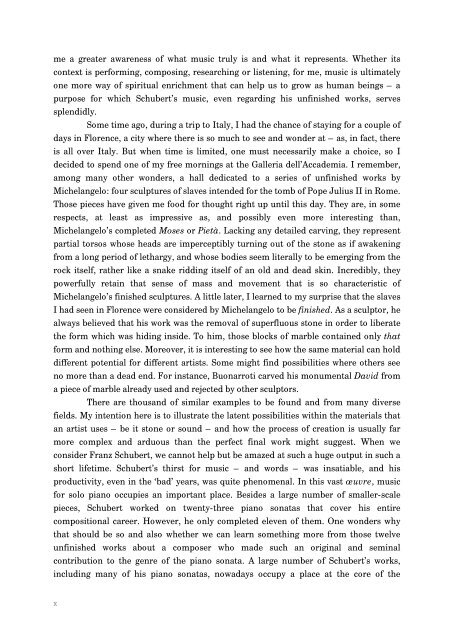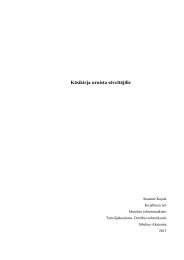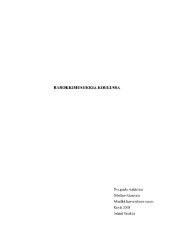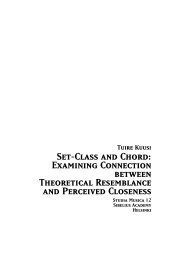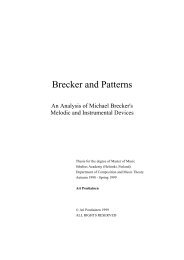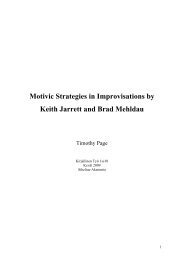The Unfinished Piano Sonatas of Franz Schubert Javier ... - Ethesis
The Unfinished Piano Sonatas of Franz Schubert Javier ... - Ethesis
The Unfinished Piano Sonatas of Franz Schubert Javier ... - Ethesis
You also want an ePaper? Increase the reach of your titles
YUMPU automatically turns print PDFs into web optimized ePapers that Google loves.
me a greater awareness <strong>of</strong> what music truly is and what it represents. Whether its<br />
context is performing, composing, researching or listening, for me, music is ultimately<br />
one more way <strong>of</strong> spiritual enrichment that can help us to grow as human beings – a<br />
purpose for which <strong>Schubert</strong>’s music, even regarding his unfinished works, serves<br />
splendidly.<br />
Some time ago, during a trip to Italy, I had the chance <strong>of</strong> staying for a couple <strong>of</strong><br />
days in Florence, a city where there is so much to see and wonder at – as, in fact, there<br />
is all over Italy. But when time is limited, one must necessarily make a choice, so I<br />
decided to spend one <strong>of</strong> my free mornings at the Galleria dell’Accademia. I remember,<br />
among many other wonders, a hall dedicated to a series <strong>of</strong> unfinished works by<br />
Michelangelo: four sculptures <strong>of</strong> slaves intended for the tomb <strong>of</strong> Pope Julius II in Rome.<br />
Those pieces have given me food for thought right up until this day. <strong>The</strong>y are, in some<br />
respects, at least as impressive as, and possibly even more interesting than,<br />
Michelangelo’s completed Moses or Pietà. Lacking any detailed carving, they represent<br />
partial torsos whose heads are imperceptibly turning out <strong>of</strong> the stone as if awakening<br />
from a long period <strong>of</strong> lethargy, and whose bodies seem literally to be emerging from the<br />
rock itself, rather like a snake ridding itself <strong>of</strong> an old and dead skin. Incredibly, they<br />
powerfully retain that sense <strong>of</strong> mass and movement that is so characteristic <strong>of</strong><br />
Michelangelo’s finished sculptures. A little later, I learned to my surprise that the slaves<br />
I had seen in Florence were considered by Michelangelo to be finished. As a sculptor, he<br />
always believed that his work was the removal <strong>of</strong> superfluous stone in order to liberate<br />
the form which was hiding inside. To him, those blocks <strong>of</strong> marble contained only that<br />
form and nothing else. Moreover, it is interesting to see how the same material can hold<br />
different potential for different artists. Some might find possibilities where others see<br />
no more than a dead end. For instance, Buonarroti carved his monumental David from<br />
a piece <strong>of</strong> marble already used and rejected by other sculptors.<br />
<strong>The</strong>re are thousand <strong>of</strong> similar examples to be found and from many diverse<br />
fields. My intention here is to illustrate the latent possibilities within the materials that<br />
an artist uses – be it stone or sound – and how the process <strong>of</strong> creation is usually far<br />
more complex and arduous than the perfect final work might suggest. When we<br />
consider <strong>Franz</strong> <strong>Schubert</strong>, we cannot help but be amazed at such a huge output in such a<br />
short lifetime. <strong>Schubert</strong>’s thirst for music – and words – was insatiable, and his<br />
productivity, even in the ‘bad’ years, was quite phenomenal. In this vast œuvre, music<br />
for solo piano occupies an important place. Besides a large number <strong>of</strong> smaller-scale<br />
pieces, <strong>Schubert</strong> worked on twenty-three piano sonatas that cover his entire<br />
compositional career. However, he only completed eleven <strong>of</strong> them. One wonders why<br />
that should be so and also whether we can learn something more from those twelve<br />
unfinished works about a composer who made such an original and seminal<br />
contribution to the genre <strong>of</strong> the piano sonata. A large number <strong>of</strong> <strong>Schubert</strong>’s works,<br />
including many <strong>of</strong> his piano sonatas, nowadays occupy a place at the core <strong>of</strong> the<br />
x


